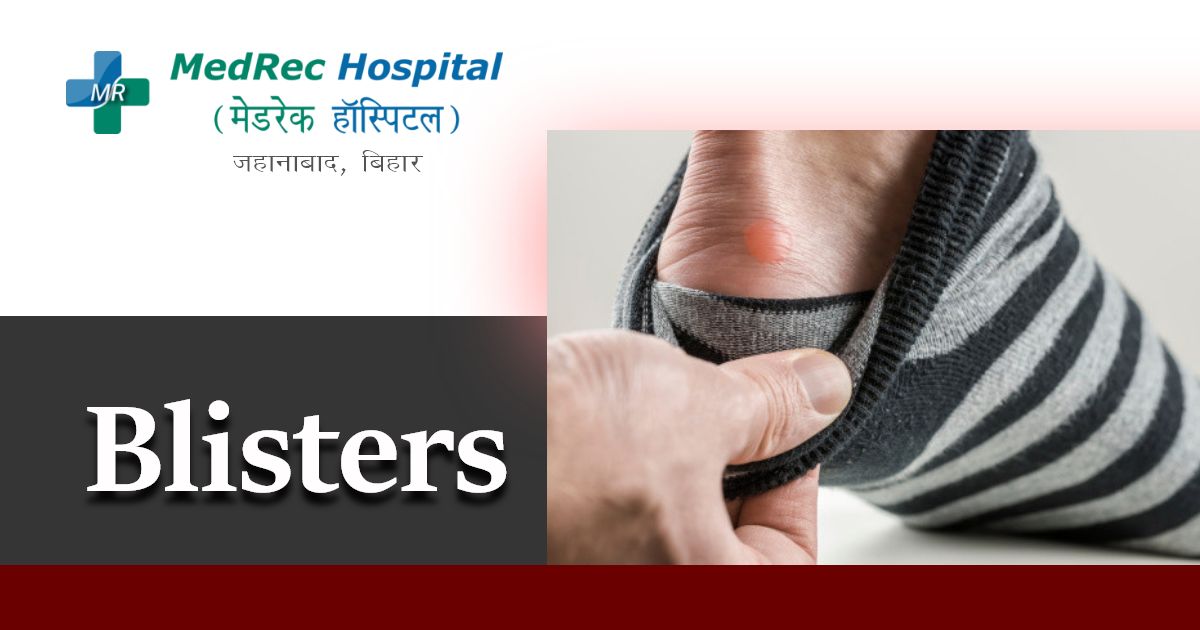
Blisters : A common skin condition that impacts
795
Usually, blisters disappear on their own within a week. You will not often need to see a doctor, although they can be uncomfortable as they heal. A pharmacist can suggest a plaster or dressing cover your blister while it heals in order to prevent infection.
A moist hydrocolloid dressing can assist to cover the blister, ease pain, and hasten to heal.
The epidermis, dermis, and subcutaneous fat make up the three layers of your skin. Under the epidermis, a fluid-filled sac known as a blister develops. Typically, depending on the injury that caused your skin damage, it may be filled with clear liquid or blood.
Blemishes can hurt or itch. A blister that develops an infection will swell and produce milky-white pus. Though they can form anywhere on the body, blisters most frequently appear on the hands or feet.
How to treat a blister on your own ?
To keep the blister safe and to aid in avoiding infection:
Blisters should be covered with a cushioned covering or soft plaster.
Before touching a blister that has burst, wash your hands.
Before applying a patch or plaster to a ruptured blister, allow the fluid within to drain.
How to check if you have blisters?
Blisters can develop for a number of reasons, including certain disorders. The most typical blister types include:
Blood blisters: When anything pinches your skin, blood blisters might form. Blood floods the area in place of the clear liquid as a result of the skin's deeper layers being damaged and broken blood vessels. A blister is created when the blood gathers.
Friction blisters: Blisters that grow from friction occur when a clear fluid accumulation occurs in the top layers of the skin. Many people develop friction blisters from excessive walking in ill-fitting footwear or by forgoing socks. They can also spread to your hands when you hold objects like shovels or other equipment.
Blisters caused by heat: These can develop as a result of burns or sunburns. They might also develop when you recover from frostbite. Skin that is blistering is a sign of a second-degree burn.
What Are The Risk Factors Of Blisters?
Blisters may be more likely as a result of the following: wearing uncomfortable shoes, repetitious use of hand tools, suffering from frostbite or a sunburn
and severe skin oedema, particularly on the legs.
Symptoms Of Blisters
Blisters most frequently appear on the hands or feet.
Some blister signs and symptoms include a raised lump or reddened, painful area of skin that is filled with clear fluid or, occasionally, blood.
Blisters Prevention
If your hands or feet frequently get friction blisters:
Wearing properly fitting shoes will help to prevent friction blisters on your foot.
Take actions such as putting on a pair of accommodating, cosy shoes and once new shoes are comfy, only wear them for brief periods of time, and also wear thick socks when working out.
Utilizing moisture-wicking socks is also beneficial. Try out some of the many socks, shoes, and insoles that are made with blister prevention in mind.
Additionally, you might try glueing a piece of moleskin to the areas of your shoes that might irritate you.
Alternatively, you might use foot powder or talc powder to dust the inside of your socks. Blisters on your hands can be avoided using gloves. If you use tools at work or while you exercise, wear protective gloves.
Blisters Treatments
Drain the liquid while keeping the surrounding skin undamaged to ease blister-related pain. This can be done as follows:
- Using soap and warm water to wash the blister and hands.
- Using iodine to clean the blister.
- Using rubbing alcohol to sharpen a needle.
- Pricking the blister many times at the edge with the needle. Keep the surrounding skin in place while allowing the fluid to drain.
- Put petroleum jelly or another ointment on the blister before wrapping it in nonstick gauze. In case of a rash, you should stop using the ointment if a rash develops.
Aftercare is very important and usually involves checking the region for infections daily. After a few days, remove the dead skin using tweezers and scissors that have been sanitized with rubbing alcohol. Put on a bandage and extra cream.
Complications of blisters
It might be that the blisters feel infected and quite uncomfortable.
A blister that is infected will include yellow or green pus and may be unpleasant, red, or heated.
Ignoring an infected blister puts you at risk for secondary impetigo, a bacterial skin infection that is contagious, as well as other problems including cellulitis or sepsis.
Additionally, you should consult your doctor if you experience blisters in odd locations, such as on your eyelids or inside of your mouth, or if they develop following a severe sunburn, burns, scalds, allergic response, or contact with chemicals or other substances.
For further information please access the following resources:
Emergency : +91 89686 77907
Front Desk : +91 98018 79584
Page last reviewed: Mar 13, 2023
Next review due: Mar 13, 2025







.jpg)
.jpg)
.jpg)
.jpg)
.jpg)
.jpg)